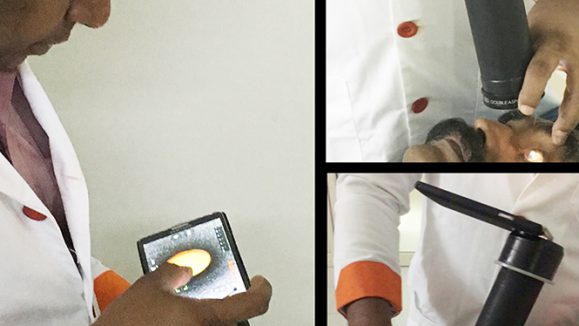Startups and large corporations lend their voices to this panel discussion concerning the risks and challenges surrounding the business of developing drugs and devices.
While innovation is exciting, going behind the scenes — to the very minds and hearts of the individuals involved in the evolution of products from beginning to the end — is also thrilling. These are the people who have seen both success — and, the better teacher of the two experiences: failure.
The industry panel discussion at the recently held OIS Retina Innovation Showcase featured a mix of voices — two from large corporations, namely Paul Hallen, the vice president and global head of Retina & Glaucoma at Alcon (Geneva, Switzerland) who is responsible for strategy and innovation in the area of retina; and Andrew Stewart, the associate vice president of U.S. Commercial Retina at Allergan. Mr. Stewart has led business development within the eyecare arena for several years and comes with a broad-based understanding of various therapeutic areas within Allergan.
Representing the smaller, earlier stage companies was Dr. Jay Duker, chief strategic scientific officer, assisting in the pipeline at EyePoint Pharmaceuticals (MA, USA) and a practicing retina specialist and chairman of ophthalmology at Tufts Medical Center (Boston, MA, USA). Before last month, he was the director of EyePoint Pharmaceuticals for the past 4 years. Completing the industry panel was Ram Palanki, senior vice president for commercial strategy and operations of REGENXBIO (MD, USA), with more than 20 years of experience in the ophthalmic industry.
In this session, moderated by Dr. Firas Rahhal, the panelists gave valuable insight into the challenges of entering and sustaining the business of drug and device development.
How do you start-up?
When it comes to startups, there are certain characteristics to assess, according to Mr. Palanki: “We talk a lot about science, capital and people. I think they come in this sequence.”
“Science is the first important thing. Then you need the capital to move it and people become an integral part of the process. When I think of startups and organizations I’ve been to, it really comes down to these three ingredients,” he said.
For assets, Mr. Palanki would ask if it’s a first-in-class product or best-in-class product. “Then it’s about the milestone for the projects. You want to get to the places to raise the capital and recruit the people you need, so you can raise the organization forward. Going into the startup world, you want to have a clear line of sight in how you want the next five years to look like based on the science you have and the capital you can raise. With that base, and the people you can bring in, [you can] start building up a serious organization,” he explained.
Fundraising for Startups
The art of fundraising and its ideal timing was also addressed.
“I’ve gone through an evolution in the past 20 years. If I had to build a startup now, it is from the ground up, where the science starts at the preclinical level. Is this validated science based on the targets you’re going after? And as to how far the targets have been, do you have an asset to get you to those targets involved?” added Mr. Palanki. He said this is where risk assessment comes into play.
“If you can take it from the preclinical stage all the way through to the IND (Investigational New Drug) phase and get to the clinic . . . that’s where you can raise serious funds,” Mr. Palanki explained.
On the other hand, Dr. Duker said if anyone wants to get themselves involved in an early stage company, you’ve got to ask yourself: “What’s the interest?”
“For me, I’ve been able to start companies and be on boards advising companies without giving up my day job as a retina specialist. It’s a little bit different when you’re putting all your chips and say, ‘this is going to be my career for a while,’ banking on the unknowns, like assets, company and team,” said Dr. Duker.
“The other thing you have to think about is this: Is there a timeline for which this lead product in the pipeline makes sense?” he added.
“You can have a great idea and it can be too early, and I think we’re seeing some of that in the AI companies. Or you can have a great idea too late, because your competitors may have completely changed the market. So you need to have a timeline set as well,” Dr. Duker shared.
He said that he enjoys looking at early assets and planning out the phases. There is room to look at the different entry points, but he cautioned that anyone getting into the business should have FDA approval and end label in mind, with a certain timeframe for approval and label in order for investors to be satisfied with the results.
“You’ve really got to follow the science. You may start out with a product and everything looks great — then, the science takes you to a different direction, which adds cost and time to the timeline. So, it’s nine-dimensional chess. At the end, you really need to have the passion for what you’re doing and like the people you’re working with,” Dr. Duker said.
Compensation while Pursuing a Company

Dr. Firas Rahhal also brought up the matter of compensation — especially for those who have jumped into starting up a company full-time.
For Mr. Palanki, he said if one was going to be recruited as a CEO, there would be a risk assessment. “Is this a place where I believe in the science behind it? And I think there’s a clear line of sight towards the landscape for the next five years,” he said.
He also said pertinent questions to ask would be if one could move the product through the different stages of evolution — from preclinical to IND approval stage.
“Can I move this product through the different stages of evolution based on where they’re trying to recruit me (i.e., early stage, proof of concept). Can I move past this stage all the way through to IND to the clinic? Because that’s where I can get to a place where I am de-risking myself personally at a compensation level to an extent and also thinking about the organizational value to the shareholders and investors,” he said.
It all depends on if one owns the asset; is trying to put a structure on it; and is trying to do the best to get the asset through these different stages — or if one is going into a company where they need you to build the asset, Mr. Palanki continued.
Development Opportunities in Larger Companies
For the larger organizations, Dr. Rahhal asked: “When you’re looking at acquisition or development opportunities, what characteristics with the asset do you look for — is it different for drugs or devices?”
Mr. Stewart said that this fundamentally boils down to the company’s strategy. He shared that for Allergan, they look at what the strategic choices or priorities they have as a franchise. “Allergan, in particular, has made a strategic decision to focus more on pharmaceutical therapeutics and less on surgical operating tactics,” he shared. He also said they wouldn’t rule out any assets related to the surgical area, but they would consider all stages of a product if they’re approached with a therapeutic asset idea, particularly in an untapped open field.
“If it’s a glaucoma drop with several options that exist today, it would have to have a really special profile or special MOA [memorandum of agreement] that will be highly differentiated for us to even look at it, potentially later into phase 3 before we get super excited looking at an asset that had that characteristics,” Mr. Stewart shared. He said they would also think of the same risk profiles when thinking of investments through different stages of development.
In the case of Alcon, Mr. Hallen said they’ve been focusing on devices: “Regardless, the asset quality is most important to us. So the degree of unmet need and the degree of how well it addresses the opportunity, effectiveness, the market tract and size, and of course, the risks.”
“We try to treat internal and external development as rigorously as possible and not give ourselves a pass on internal development. We’re agnostic to where it comes from and we’ve gotten better at that, and our rates of acquisition have gone way up. “As far as stages of development, we’re interested in many stages, but the level of risks and numbers of external companies pursuing that particular area is of consideration,” Mr. Hallen shared.
“We may make contact with them and monitor, versus really pursue one technology if we’re letting the data streams play out, and see which one is really going to be the winner. You don’t really want to pick the wrong horse early. So in any case, if the technology is not clear, or if it’s clearly a high-risk scenario, we’re willing to wait and feel we have the opportunity to get it when it comes to the negotiation table,” he added.
Furthermore, Mr. Hallen emphasized that there’s not much difference between drugs and devices, except that there’s a higher risk profile for drugs.
Mr. Stewart gave his viewpoint on taking risks: “Buying in late and buying expensive also has a very short timeline before you find out the answer to the question. So as an example, making a multibillion dollar acquisition in retina that loses in phase 3 is an awfully difficult value proposition to swallow in the short run, versus having earlier stage investments which certainly increase the amount of the risk but definitely lowers the cost — and gives you a greater opportunity to take more shots on goal.”
“I think it really depends on the circumstances on what the therapeutic area may be and the risk-reward associated,” he said.
Mr. Hallen noted: “For us in retina-speak, all cases are like snowflakes. Each one is different. If we really look backward at what we’d done, we’ve had to alchemize on whatever products we acquire anyway with very high standards.
“Particularly, it can be around ease-of-use or reliability, not necessarily the innovation and the main value of the device. But if you look back, that’s what happens, so getting in early isn’t necessarily a bad thing, but we need to look at each one uniquely and determine when is the best time to get in,” explained Mr. Hallen.
“I worry about picking the wrong one or missing out, more than anything else,” he noted.
Facing Failure for Big Guns
Dr. Rahhal asked the members of the panel: “In big corporate structures, how do you recognize when something goes wrong? How do you assess what changes to make and when to pull the plug?”
Mr. Hallen answered metaphorically: “It’s like a vitrectomy that does not go as well as planned. The expected 30-minute case starts to approach an hour. There are signals in that surgery you start picking up. Mitigations. Detours. And eventually, it’s not a great scenario . . . so, it’s time to close and just remove the cannulas. I think it’s the same thing here.
“I’ve been on multiple sides in this equation as a VP at Alcon. I’ve been involved in R&D, in internal and acquisitions, and also as VP of Alcon commercial and VP in a startup,” he shared. “So, it’s very similar. I see things like abrupt changes, significant changes in approach of design and strategy. Lack of clarity in milestones when they can’t tell what’s next and answer that question. It’s hard to move to the next milestone,” he added.
Contributing to this topic, Mr. Stewart added: “The hardest part is probably getting the entire organization to recognize what that risk is and facing it, and being honest about it with themselves. People spend their careers developing assets that sometimes get very late in development and never wind up seeing the light of day. And facing those realities of wind-ups is a cultural challenge within an organization for sure.
“I think with retina, to be direct with you, over the last several months, we’ve seen safety as the biggest challenge within the new and native assets that we’ve had,” he highlighted.
According to Mr. Stewart, organizations will have to learn from these lessons and experiences to go through the growing pains.
“Beyond [just a] hunch, the big part of decisions need to be data-driven, especially when making hundreds of millions of dollar decisions for long-term viability of assets,” he added.
Strategy in the Messaging
For Mr. Stewart, it’s a collaborative effort in large companies with different people playing different roles within investor relations, public relations, commercial and medical, and clinical. As a large conglomerate, he said the messaging needs to be immediate and thorough where that’s possible and when the story is fully understood.
“It needs to be communicated. There needs to be hard and fast rules, not only from an ethical standpoint, but fiduciary, too,” he said.
The key is to not “jump the gun” or jump to conclusions, said Mr. Hallen. “First, get the facts, hopefully data. Assess the situation. Develop options. Be creative. Be flexible. Then you need to determine the best option and best path forward. You need to be decisive. You can execute with confidence or exit and cut your losses. I think communication follows that and the process that you follow to make sure you make the right decision . . . so be deliberate, basically,” he explained.
Getting a Grip on Failures in Startups
For startups assessing failure in projects, Mr. Palanki offered insights from his personal experiences.
“In business, we have risks at every stage and we have to assess that risk at every stage honestly, based on data, and make decisions for that evolution as you go through the organization,” he said.
He cited failures, like Jetrea, of which he was a part of its development from scratch.
“Even as you come out of phase 3, you have to have an honest look at the data in terms of risk-benefit and ensuring that you’re setting that expectation in the community in a proper fashion. And you have to ensure you’re going after the right target patient population. All of that matters. It’s about expectation management, and that comes from setting expectations,” shared Mr. Palanki.
“So, if you really focus on all those aspects through evolution and really understand where you start the division and how the data has helped you to be flexible with that vision, and really getting to the end — you’ll execute it based on that evolution and I think you’ll be successful,” he said.
Also, according to Mr. Palanki, the definition of success might change too, over time.
“You might start with a whole vision for a billion dollar product and by the time you get through phase 3 and look at the data, you might find it’s a 200-million dollar product. But if you come to grips with that aspect of the business, then you would actually launch the product with the right infrastructure and right operation model and you’ll make it profitable,” he explained.
It really depends, he said, on your approach: “If you set a vision, you’re pragmatic, you’re flexible, you’re disciplined, you execute and maintain the speed and get there, a lot of things could change still — your market profile or product profile might change.
“You have to be really adaptable and flexible to ensure your product becomes successful in the environment you’re launching into,” noted Mr. Palanki. “And maybe your profile comes into a place where it’s not possible to launch into the market then you’ll have to make decisions at that point.”
Whose fault is it?
When a company fails, is it the management’s fault? Is it the drug’s fault?
According to Mr. Palanki, there are multiple aspects to this when you start looking at risks.
“It’s about evaluating the risk at every stage, aligning with the entire management team and executive team to make sure everybody clearly understands how the evolution is taking place. So, when you come to the end, expectations have been aligned internally and externally in the organization,” he reiterated.
However, in Dr. Duker’s books on failures, he cited cases like Beovu. “We all have stories like that. If you’re in biotech, you’ll have failures,” he said.
“When I was a clinician, I didn’t really understand the back parts of drug development. It’s the analogy Paul [Hallen] said about the vitrectomy. It’s a three-hour case, but in the end, the patient sees better and the patient has no idea what went into that case and how close it was to losing the eyes. That to me is drug development in a nutshell when you’re on the outside,” explained Dr. Duker.
“I do the same thing I do when I’m in the operating room. I want a plan A, plan B and plan C, and I’m going to think through the upcoming events. What happens if we see this, what are we going to do? Obviously, if you’re a private company you’ve got the board and shareholders to answer to,” he said.
People tend to think it’s simple to invest in an early stage company platform — not realizing the special risk of failure that startups take, he deems.
“In early companies, you’ve got to hit on that first product or you’re going to run out of money. There are very few companies that can survive a first failure. So you have to understand that, you have to have multiple shots on goal. This might not be the best-selling product on our portfolio, but this has better be the one that de-risks . . . because if it doesn’t work, we’re probably done,” explained Dr. Duker.
He said failure might mean a reverse merger or returning money to shareholders.
“For early stage companies, it is difficult because you don’t have a great market cap or good looking balance sheet to fall back on if you have to cut yourself loose,” he said.
“We can’t all be Moderna,” he said in jest.
Editor’s Note: OIS Retina Innovation Showcase, organized by Ophthalmology Innovation Source (OIS) was held on September 10. This high-impact program delivered a retina market overview, presentations and panel discussions with KOLs and industry executives.





